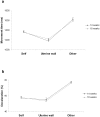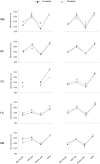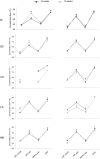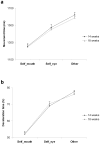Wired to be social: the ontogeny of human interaction - PubMed (original) (raw)
Wired to be social: the ontogeny of human interaction
Umberto Castiello et al. PLoS One. 2010.
Abstract
Background: Newborns come into the world wired to socially interact. Is a propensity to socially oriented action already present before birth? Twin pregnancies provide a unique opportunity to investigate the social pre-wiring hypothesis. Although various types of inter-twins contact have been demonstrated starting from the 11(th) week of gestation, no study has so far investigated the critical question whether intra-pair contact is the result of motor planning rather then the accidental outcome of spatial proximity.
Methodology/principal findings: Kinematic profiles of movements in five pairs of twin foetuses were studied by using four-dimensional ultrasonography during two separate recording sessions carried out at the 14(th) and 18(th) week of gestation. We demonstrate that by the 14th week of gestation twin foetuses do not only display movements directed towards the uterine wall and self-directed movements, but also movements specifically aimed at the co-twin, the proportion of which increases between the 14(th) and 18(th) gestational week. Kinematic analysis revealed that movement duration was longer and deceleration time was prolonged for other-directed movements compared to movements directed towards the uterine wall. Similar kinematic profiles were observed for movements directed towards the co-twin and self-directed movements aimed at the eye-region, i.e. the most delicate region of the body.
Conclusions/significance: We conclude that performance of movements towards the co-twin is not accidental: already starting from the 14th week of gestation twin foetuses execute movements specifically aimed at the co-twin.
Conflict of interest statement
Competing Interests: The authors have declared that no competing interests exist.
Figures
Figure 1. Types of movements.
a, Video frame representing a self-directed movement towards the mouth. b, Video frame representing a self-directed movement towards the eye. c, Video frame representing the foetus reaching towards and “caressing” the back of the sibling. d, Video frame representing the foetus reaching towards and “caressing” the head of the sibling.
Figure 2. Frame of reference and measurement unit used to refer the examined body position.
a, Intraocular distance and position of the wrist marker. b, Axes used to perform the 2D kinematic analysis.
Figure 3. Schematic representation of the analysis considering the proportion of each type of movement.
Proportion of movements performed by the foetuses towards the self, outer-directed movements and movements towards the co-twin at the 14th - (solid line) and 18th – (dashed line) week of gestation. Error bars represent the standard errors of the means.
Figure 4. Kinematic profiles for different types of movement at the 14th and 18th week of gestation.
Movement duration and deceleration time for self-directed movements, non-target movements and social movements at the 14th and 18th week of gestation. a, Movement duration was longer for arm movements performed towards the sibling than for movements performed towards the self and outer-directed movements both at the 14th and at the 18th week of gestation. b, Independently of the period of gestation, the percentage of time spent decelerating was greater for movements performed towards the sibling than for those performed towards the self and outer-directed movements. Error bars represent the standard errors of the means.
Figure 5. Movement duration for different types of movement at the 14th and 18th week of gestation for each foetus.
Figure 6. Deceleration time for different types of movement at the 14th and 18th week of gestation for each foetus.
Figure 7. Kinematics adaptation to the properties of the target.
Movement duration and deceleration time for self-directed movements towards the mouth and the eye region, and movements directed towards the sibling at the 14th and 18th week of gestation. a, Movement duration for movements performed towards the co-twin was longer than for self-directed movements towards the eye or the mouth. Duration of movements towards the eye region was longer than for those directed towards the mouth. b, The percentage of time spent decelerating was greater for movements towards the co-twin than for movements towards the eye or the mouth. Deceleration time for movements towards the eye region was longer than that for those directed towards the mouth. For both dependent measures the size of the target effect was comparable at the 14th and 18th week. Error bars represent the standard error of the means.
Similar articles
- The development of upper limb movements: from fetal to post-natal life.
Zoia S, Blason L, D'Ottavio G, Biancotto M, Bulgheroni M, Castiello U. Zoia S, et al. PLoS One. 2013 Dec 4;8(12):e80876. doi: 10.1371/journal.pone.0080876. eCollection 2013. PLoS One. 2013. PMID: 24324642 Free PMC article. - Evidence of early development of action planning in the human foetus: a kinematic study.
Zoia S, Blason L, D'Ottavio G, Bulgheroni M, Pezzetta E, Scabar A, Castiello U. Zoia S, et al. Exp Brain Res. 2007 Jan;176(2):217-26. doi: 10.1007/s00221-006-0607-3. Exp Brain Res. 2007. PMID: 16858598 - Simultaneous recording of fetal breathing movements and body movements in twin pregnancy.
Zimmer EZ, Goldstein I, Alglay S. Zimmer EZ, et al. J Perinat Med. 1988;16(2):109-12. doi: 10.1515/jpme.1988.16.2.109. J Perinat Med. 1988. PMID: 3050014 - Ultrasound in twin pregnancies.
Morin L, Lim K; DIAGNOSTIC IMAGING COMMITTEE; SPECIAL CONTRIBUTOR; GENETICS COMMITTEE; MATERNAL FETAL MEDICINE COMMITTEE. Morin L, et al. J Obstet Gynaecol Can. 2011 Jun;33(6):643-656. doi: 10.1016/S1701-2163(16)34916-7. J Obstet Gynaecol Can. 2011. PMID: 21846456 Review. - Weight discordance and perinatal mortality in twin pregnancy: systematic review and meta-analysis.
D'Antonio F, Odibo AO, Prefumo F, Khalil A, Buca D, Flacco ME, Liberati M, Manzoli L, Acharya G. D'Antonio F, et al. Ultrasound Obstet Gynecol. 2018 Jul;52(1):11-23. doi: 10.1002/uog.18966. Ultrasound Obstet Gynecol. 2018. PMID: 29155475 Review.
Cited by
- Social Touch: Its Mirror-like Responses and Implications in Neurological and Psychiatric Diseases.
Grandi LC, Bruni S. Grandi LC, et al. NeuroSci. 2023 May 26;4(2):118-133. doi: 10.3390/neurosci4020012. eCollection 2023 Jun. NeuroSci. 2023. PMID: 39483320 Free PMC article. Review. - Will the Artificial Intelligence Touch Substitute for the Human Touch?
Grandi LC, Bruni S. Grandi LC, et al. NeuroSci. 2024 Jul 24;5(3):254-264. doi: 10.3390/neurosci5030020. eCollection 2024 Sep. NeuroSci. 2024. PMID: 39483277 Free PMC article. Review. - Altered somatosensory processing in adult attention deficit hyperactivity disorder.
Frost-Karlsson M, Capusan AJ, Olausson H, Boehme R. Frost-Karlsson M, et al. BMC Psychiatry. 2024 Aug 13;24(1):558. doi: 10.1186/s12888-024-06002-9. BMC Psychiatry. 2024. PMID: 39138461 Free PMC article. - How material sensory properties and individual differences influence the haptic aesthetic appeal of visually presented stimuli.
Campagna M, Chamberlain R. Campagna M, et al. Sci Rep. 2024 Jun 13;14(1):13690. doi: 10.1038/s41598-024-63925-9. Sci Rep. 2024. PMID: 38871744 Free PMC article. - Back to square one: the bodily roots of conscious experiences in early life.
Ciaunica A, Safron A, Delafield-Butt J. Ciaunica A, et al. Neurosci Conscious. 2021 Nov 20;2021(2):niab037. doi: 10.1093/nc/niab037. eCollection 2021. Neurosci Conscious. 2021. PMID: 38633139 Free PMC article.
References
- Braten S. Amsterdam/Philadelphia: John Benjamin's Publishing Company; 2009. The Intersubjective Mirror in Infant learning and Evolution of Speech.
- Gallese V, Rochat M, Cossu G, Sinigaglia C. Motor Cognition and its role in the phylogeny and ontogeny of intentional understanding. Dev Psychol. 2009;45:103–113. - PubMed
- Reddy V. Harvard, MA: Harvard University Press; 2007. How Infants Know Minds.
- Reid VM, Striano T, Koops W. Hove: Psychology Press; 2007. Social cognition during infancy.
- Striano T, Reid VM. Social cognition in the first year. Trends Cog Sci 10: 471- 2006;476 - PubMed
Publication types
MeSH terms
LinkOut - more resources
Full Text Sources






